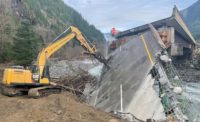This October, Nord Embroden, a professor emeritus of CAD and construction management—who also has twice held the world speed record for land yacht sailing—expects to ascend the tower at the Flight 93 National Memorial near Shanksville, Pa., to finally adjust the rigging of 40 aluminum sails he designed to empower the tower to talk.
The “Tower of Voices” is the last element of the three-phase, $56-million project to create the memorial park. Paul Murdoch Architects, Los Angeles, won the design competition in 2005 with a proposal that included a 93-ft-tall tower housing 40, 5- to 10-ft-long, 8 in.-dia., tubular wind chimes.
The chimes’ random melodies of pure harmonious notes, with sometimes dissonant resonances, are meant to evoke the voices of the passengers and crew on Sept. 11, 2001, as captured by cockpit recordings and phone messages left for loved ones in the flight’s last moments as they battled hijackers apparently bent on using the plane to strike Washington D.C. The voice theme threads through the memorial’s expansive landscaping, visitors’ center and signature tower.
But in 2018, with the structure of the tower finished and its September dedication fast approaching, Paul Murdoch, the design firm’s founder, president and leader of the project, and his team of consultants and engineers were still struggling to get the chimes to speak.
The “voices” were dedicated in a “soundbreaking” ceremony Sept. 8, 2018 with only eight chimes in place. Murdoch says that while the sounds were beautiful, the winds were light and the mechanism to harness it failed to deliver the neat, frequent, powerful, strikes required to get the chimes to converse. Metal sails that were supposed to catch the wind and swing the strikers spun ineffectually. Turning to a back-up plan, the chimes were manually rung with ropes for the ceremony.
Murdoch says that what seemed at first to be a relatively simple engineering task had turned out to be an “enormously difficult” problem to solve. He had come to realize that, given the structural and performance constraints already locked into the project, the original sail designs weren’t going to work. “We had an overly robust assembly that was made to last and take a lot of forces, but it wasn’t buoyant enough to behave in the wind,” he says. “That’s when I realized we need to bring in someone who could reconcile these two ends of the spectrum.”
In March of 2019, as he stood at a podium to accept one of ENR’s annual Newsmaker Awards for the project, Murdoch recalls saying, “So if there’s anybody in the audience who knows how to do wind chimes, we’re open to it," adding, “I don’t think they took me seriously. But that was a real thing.”
Iterations
The problem was that the sails didn’t generate enough power to overcome the ever-growing heft and complexity of the stainless steel assemblies of strikers, hanger rods and flexible connectors suspending them and the sails below, along with governors to limit the sails’ travel to avoid collisions in the crowded confines of the tower.
Every piece had to endure high, repetitive stresses and survive a harsh environment of constant motion, year after year, decade after decade. Every element had to be rated to survive a 400-year storm and loads of 4.73 KPs (4,730 lbs).
Murdoch says the design and engineering process had been highly iterative, with sequences of modeling, mock-ups and prototypes evaluated for design adjustments every step of the way. It started in Nov. 2016 with the chime tubes, followed by the tube suspension system, the strikers, and the sails.
The designer’s contract with the National Park Service recognized it would be a phased process under a series of specific scopes and lump sum fees, Murdoch says. “Each discreet iteration would provide greater clarity of the needs for a next phase. There was a shared risk by both the design team and the owner, which we tried to reconcile as best as possible.”
The chimes project was put on ice for months on two occasions, once from October 2018 to April 2019 due to the government shutdown and again through the same months the following year by the Park Service after the dedication. “The Park Service wanted to take a step back and evaluate what it would take to keep going,” Murdoch says.
Constraints
Murdoch had assembled an unusual team of specialists to help solve many puzzles that arose in the design process. In addition to more conventional resources like structural, dynamic, mechanical and acoustic engineers from Arup, he engaged a musician and tuning theorist, a chimes artist, and wind consultants to develop the chime tubes and to figure out the notes they should play.
One of the first tests had been to prove if the idea of hiding the chimes’ stainless steel strikers and their impacts inside each of the 8-in.-dia. cylindrical aluminum tubes would work. Murdoch’s vision was to give each chime an “inner voice,” he says. “We felt symbolically that was truer to the memorialization we were after.”
But the walls of the chimes are ½ in. thick, and with the 3-in.-dia. strikers taking up the centers, the strikers have only two inches, from rest, to accelerate and strike the tubes hard enough to sound notes.
Murdoch says his chimes-artist consultant, Gregg Payne, of Gregg Payne Art & Design, didn’t think internal strikers would work, but field tests in August 2017 proved they could. Acoustic engineers from Arup SoundLab in Los Angeles captured full-spectrum, three dimensional sound recordings of each of the seven lengths of chimes to analyze the quality and amplitude of their resonance using different striker masses and damping materials.
During the tests, the idea of hanging the sails from the strikers with stainless steel cables bit the dust after the cable failed by the end of the day one, Murdoch says. That led to another round of modifications and mockups for new links between the strikers, sails and governors using stainless steel rods, shackles and ball joints.
The new assemblies were tested on a tower outside of Fugate Inc., a drum and percussion instrument maker in Morton, Ill., on several occasions in 2018, but each modification added to the mass and complexity of the mechanism and further dampened the wind response.
Murdoch admits he despaired “many times” that they might not be able to get the voices to work. “This was very difficult with all of those challenges, but those three in particular: the confines of the tower, the configuration of the tubes, this thing having to behave in the wind and stand up to the wear and tear, those were formidable enough, but then it comes down to the design of each of these combinations and understanding how they would all behave as an assembly .... The final design turned out to be much more challenging than anybody anticipated,” he says.
As Murdoch struggled to harness the wind, he started discussing the problem with sailors “because they are familiar with how to read the wind and harness wind power for movement,” he says. But, he found that, even though they had a good understanding of wind behavior, everything they suggested for adapting sailboat gear would not survive decades of service and extreme conditions. Then, in April 2019, one sailor suggested he talk to Nord Embroden, who was said to know how to design and build high performance air foils and very tough, light, wind-driven machines.
Embroden is a 70-year-old professor emeritus at Victor Valley College, Victorville, Calif., where he developed and still teaches programs in architecture and building trades, drafting and engineering, construction and manufacturing technology, and where he also launched one of the first CAD courses in the nation in the early 1980s. His father was a nautical engineer, and Embroden says he has been building land-sailing craft since he was a child. He held onto one of his two world records for land yacht speed for 20 years and now runs Nord Design, a land yacht design and fabrication business, as head designer, chief engineer and CEO.
“This was supposed to be a fairly quick project,” Embroden recalls. “We went through every piece of that chime assembly and I remember Paul said, ‘We have all these parts and we want you to use everything you can,’” Embroden says. “I had to try not to waste a whole series of manufactured pieces—almost every piece is custom made, and what is not, is rare or rarely used. It had gotten engineered and engineered and finally it didn’t work.”
Quite a Puzzle
Embroden explains, “it was a tricky problem because we needed to meet these really high standards for architectural engineering purposes, [but] the amount of movement allowed for the sail to build up to full speed is only three or four inches. It has to go from zero to max speed and strike the chime, and then reset itself. It was quite a puzzle.”
Murdoch says they started with a two-day workshop at Arup to introduce Embroden to the project in April, 2019, “and by October we were able to test some sails that successfully produced wind-driven strikes.” The first sails were plywood mockups of three designs. Prototypes were then fabricated in aluminum by Fugate in Illinois and tested. Each had different behavioral characteristics, but they all worked, demonstrating the proof of concept.
The National Park Service selected the most high-energy of the three designs, but then shut the project down for six months while it assessed how best to go forward and determined the resources needed to move from conceptual prototype to full fabrication and installation, Murdoch recounts. It replaced Fugate with ARCH Production and Design LLC, Blauvelt, N.Y. for the next phase. ARCH ultimately fabricated the 40 chimes and installed them in September 2020.
When the park service eventually gave the green light to resume, the team jumped back to work, and focused on re-analyzing the entire chimes assembly to look for ways to lighten and simplify it.
“I kind of put it on a diet,” says Embroden of the effort to lighten the assembly. One element he wanted to replace was a lower rod and ball-joint assembly to limit the sails’ range of motion. He suggested a rope tether, instead.
Murdoch says he had proposed rope early on, but the idea was rejected by the engineers over doubts about rope’s strength and endurance. That’s when Embroden brought up an ultra-high molecular weight polyethylene rope marketed under the name Dyneema by DSM, in the Netherlands. It is billed as the world’s strongest fiber. According to company literature, supertankers and tugs are using it for mooring and towing lines because of its high strength, light weight and long life. Ropes made with it have a slightly higher strength than steel wire at the same dimension while being 7 to 10 times lighter in weight, DSM claims.
“It’s a really good rope, and it holds up well.” Embroden says.
Murdoch says the engineers were still dubious but may have been swayed by Nord’s deep experience with rope. “The other thing was seeing how limiting that expensive piece of metal fabrication was, and that there wasn’t a good likelihood of a mechanism like that working,” Murdoch says. The project “took on a new life as we got back into it,” he adds.
High-Powered Sails Were Key
Embroden’s high-powered sails were the key. They rapidly accelerate and produce solid striker impacts because of their configurations as paired, parallel, vertical air foils, with the leading edge of one placed a little behind, and inside of the other. Flat plate “air dams” wider than the ends of the paired foils are set perpendicularly to cover their tops and bottoms. The dams prevent power-robbing turbulence and keep the stream of wind traveling parallel with the airfoil.
Embroden explains that physics requires molecules traveling across the inside and the outside of the foil join back together at the trailing edge in the same relationship they had before they were parted to go around the sail. That causes the molecules streaming across the longer outside curve to spread out to keep up with those crossing the shorter inside path, which creates a pressure drop on the longer side, relative to the pressure on the inside—or lift. The shape of the sail’s curve makes the lift force stronger at the forward end which shoves the sail forward, and the speed of that motion is added to the wind speed, increasing the apparent speed of the wind at the front edge of the sail.
“We work with the apparent wind.” Embroden explains. “Power goes up very rapidly, which increases the forward speed of the sail, which again increases the apparent wind speed, and the cycle continues.” The second, overlapping foil, acts as an amplifier. Using these principles, Embroden’s land yacht, Silver Bullet, has clocked speeds seven times faster than the actual wind.
Embroden, also specified a fabrication and assembly process that emphasizes keeping the airflow clean by avoiding even tiny obstructions. The sails can be flipped top-to-bottom for either right- or left-hand installation, depending on the wind behavior at the chime location. He also designed pivoting brackets at both ends with selectable connection points to allow the sails to be hung at slight, forward-leaning angles. The brackets pivot to ease the strain on the structure when the tethers jerk the sails to a halt at the end of their travel.
Embroden specified differing connection points for setting up the tethers for specific chimes, depending on the wind characteristics at each location in the tower. He also suggested switching to lightweight swivels that rock climbers use, from Rock Exotica LLC, Clearfield, Utah, to further lighten the tethers.
When the tethers are correctly set and the sails angled just right, they race forward into the wind but are brought up short by the tether as the striker makes impact. The sudden halt on the slightly off center tether connection at the pivoting bottom bracket causes the leading edge of the sail to twist into the wind, or luff, which de-powers the sail and lets it drop back and reset to go again.
The key to getting the Tower of Voices to talk often and strongly hinges on sail performance, which Embroden hopes to optimize when he has his first chance this October to tune the sails the fabricators installed last year. This will result in more conversation among the chimes in lighter winds, “expanding the operable range of the tower,” he says.
“It was a difficult technical thing to solve,” Murdoch says of the process of working out how heavy the parts have to be to handle the fatigue loads and day-to-day forces, yet still be responsive to the wind, but in the end, the tower speaks, and hopefully, after Embroden’s adjustments in October, it will talk even more. Murdoch says, “It’s really quite a beautiful and brilliant sail design.”

















Post a comment to this article
Report Abusive Comment